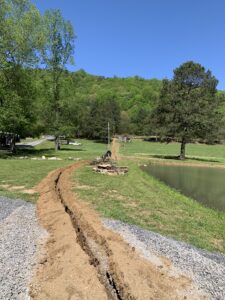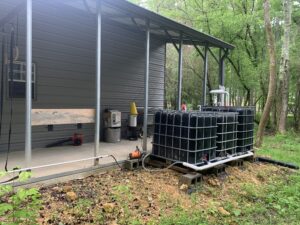Insurance costs money. So does resiliency. We designed resiliency into our plans in part, because we’re out in the middle of nowhere and because we think it is wise not to be totally dependent on third parties for daily necessities. With the world becoming increasingly unstable, a recklessly growing national debt, national climate policy that is eroding our energy security, raising prices and destabilizing our electric grids, we think resiliency is wise. The first step was water resiliency.
Water
We have two wells on the property. A deep well provides drinking water to the guest house and a shallow well has been unused for more than a decade but appears viable. Our plan is to tap into county water so that we will have a choice of water sources for each house, gardens and pastures.
Getting county water was straightforward albeit expensive. We trenched from the newly-installed meter tap to the well house, then to the new house. This required 600 ft of 1-inch PEX inside PVC conduit.

The water line and well pump output come together into a manifold in the utility room where we select the water source for each house. Another trench runs between the two houses.
We installed rainwater reclamation tanks behind the garage and outfitted them with a transfer pump to provide water for both raised garden beds and as back- up for the garage and barn.

When the main water line was being trenched, we installed three hose bibs in the South pasture so we would have fresh water for sheep and cattle within a 100 ft hose reach. The pasture water source is also redundant.
Electricity
We are building an energy-efficient home powered by grid-tied solar and propane. In so doing, we are not 100% dependent on a single energy source. The mostly-electric home will have propane heat back-up by way of a direct vent fireplace, a propane on-demand water heater and propane cooktop. To minimize energy demand, we chose a variable speed multi-zone heat pump system with an energy recovery ventilation system (ERV) to provide adequate fresh air and a heat pump clothes dryer.
A Sol-Ark 15k hybrid inverter will manage our electricity supply and charge our battery bank. When we get a solar PV array up (2024 due to budget constraints) the inverter will minimize use of the grid based on solar output and the battery state of charge. If we lose grid power for sustained periods, Steve hooked us up with a Generac propane generator which the Sol-Arc will operate as-needed to re-charge the batteries.
We plan on a minimal initial battery investment of 10 KWh with the ability to add more later, if desired. The solar array too will be modest because of our unfavorable wholesale buyback rates here ($.035/KWh). It just doesn’t pay to build extra solar capacity in our case. Otherwise we would put a substantial ground mount system on one of the pastures and sell back to the utility. Perhaps someday if economics change. As-is, our aim is to produce 80% of our average energy needs using solar. Once we’re living in the house for a few seasons, we should be able to determine the optimal battery capacity needed. Extra capacity is expensive🙂
